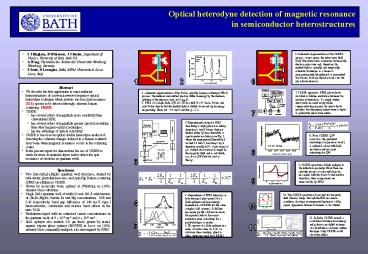Optical heterodyne detection of magnetic resonance - PowerPoint PPT Presentation
1 / 1
Title:
Optical heterodyne detection of magnetic resonance
Description:
Optical heterodyne detection of magnetic resonance. in semiconductor heterostructures ... based on an optical double heterodyne method of detecting the coherent ... – PowerPoint PPT presentation
Number of Views:380
Avg rating:3.0/5.0
Title: Optical heterodyne detection of magnetic resonance
1
Optical heterodyne detection of magnetic
resonance in semiconductor heterostructures
- S J Bingham, D Wolverson, J J Davies, Department
of Physics, University of Bath, Bath UK - A Waag, Physikalisches Institut der Universität
Würzburg, Würzburg, Germany - P Prete, N Lovergine, IMM, INFM, Università di
Lecce, Lecce, Italy
6. Schematic representation of the CRESR process
at resonance, the microwave field (dark blue)
introduces coherence between the electron spin
states and, therefore, the emitted light is
spatially and temporally coherent it emerges as
a beam co-propagating with the reflected or
transmitted laser beam. Both are then focussed
onto the photodiode detector.
2
1
6
- Abstract
- We describe the first application to
semiconductor heterostructures of a new
microwave-frequency optical heterodyne technique
which enables electron spin resonance (ESR)
spectra to be detected through coherent Raman
scattering CRESR. - CRESR
- has several orders of magnitude more sensitivity
than conventional ESR - has several orders of magnitude greater spectral
resolution than other magneto-optical techniques - has the advantage of optical selectivity.
- CRESR is based on an optical double heterodyne
method of detecting the coherent changes induced
in a Raman scattered laser beam when magnetic
resonance occurs in the scattering centre. - In the present report we demonstrate the use of
CRESR to study electrons in epitaxial layers and
to detect the spin resonance of electrons in
quantum wells.
1. schematic representation of the Stokes
spin-flip Raman scattering (SFRS) process the
incident and emitted photons differ in energy by
the Zeeman splitting of the electron state, DE
gmBB. 2. SFRS of a single ZnSe QW at 1.5K in a
field B of 6 Tesla. Stokes and anti-Stokes denote
that the emitted light is shifted down and up in
energy respectively. Here, DE 0.4 meV and thus
g 1.1.
7. CRESR apparatus. PEM photoelastic modulator
switches excitation between two circular
polarizations S sample within microwave
resonant cavity inside superconducting magnet
fast photodiode provides beat frequency
(microwave) output to quadrature microwave mixer
7
3. Experimental setup for SFRS. Sensitivity is
high (photon counting detection is used) but
resolution is limited either by laser linewidth
or spectrometer resolution (see Fig. 1, where the
experimental linewidth is around 0.1 meV).
Accuracy of g is therefore usually ?1.
Anisotropy of g is studied via rotation of sample
in the magnetic field and is calculable, e.g.,
for a QW (below), via k.p theory.
8. First CRESR QW spectrum the predicted
sensitivity (our previous work) is achieved,
along with high resolution and resonant
selectivity for QW.
8
3
9. CRESR spectrum of ZnSe epilayer in the
reflection geometry. More than one spin-flip
process is seen with laser in resonance with the
donor-bound exciton transition these components
are unresolvable by SFRS.
- Specimens
- Two ZnSe/(Zn,Be,Mg)Se quantum well structures,
studied by reflectivity, photoluminescence and
spin-flip Raman scattering (SFRS) in addition to
CRESR. - Grown by molecular beam epitaxy at Würzburg on
(100)-oriented GaAs substrates - Single ZnSe quantum well of width 95 and 190 Å
with barriers of (Zn,Be,Mg)Se barrier Be and Mg
concentrations 0.08 and 0.10 respectively band
gap difference of 240 meV type-I
heterostructure conduction and valence band
offsets in the ratio 7822 - Modulation-doped with an estimated carrier
concentrations in the quantum wells of 8 ? 1010
cm-2 and 4 ? 1010 cm-2. - ZnSe epilayer also studied 0.8 ?m thick grown
by metal-organic vapour phase epitaxy (MOVPE) at
Lecce on (100)-oriented GaAs nominally undoped
also investigated by SFRS.
9
10. The CRESR spectrum above (red) for magnetic
field (black) sweeps through the ESR resonance
condition, showing an unexpected hysteresis of
the signal dynamical behaviour remains to be
studied.
4. Dependence of SFRS intensity on laser energy
(open squares) for a ZnSe epilayer and laser
energy dependence of CRESR for the same sample
(solid squares). Solid line resonance profile of
form shown in the equation below. Resonant
excitation gives selectivity for a particular
layer or centre. 5. PL spectra of a ZnSe epilayer
in a series of strain states (L to R on
substrate, free-standing, glued to silica latter
was used for CRESR)
4
10
11. In ZnSe, CRESR reveals a correlation between
laser energy and g-factor, modelled in terms of a
distribution of strains within the layer. Only
CRESR could show this effect.
5
11































